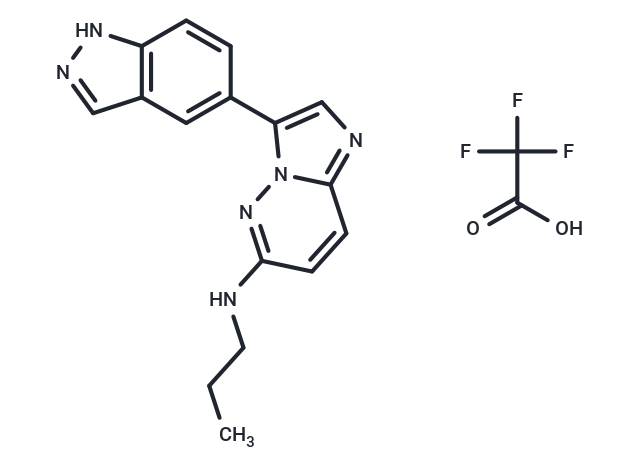Shopping Cart
Remove All Your shopping cart is currently empty
Your shopping cart is currently empty
CHR-6494 TFA is a potent haspin inhibitor with an IC50 of 2 nM, inhibiting histone H3T3 phosphorylation. It induces apoptosis in cancer cells, including melanoma and breast cancer, and is useful for cancer research.

| Pack Size | Price | USA Warehouse | Global Warehouse | Quantity |
|---|---|---|---|---|
| 1 mg | $58 | In Stock | In Stock | |
| 5 mg | $130 | In Stock | In Stock | |
| 10 mg | $211 | In Stock | In Stock | |
| 25 mg | $353 | In Stock | In Stock | |
| 50 mg | $503 | In Stock | In Stock | |
| 100 mg | $696 | In Stock | In Stock | |
| 200 mg | $938 | In Stock | In Stock | |
| 1 mL x 10 mM (in DMSO) | $153 | In Stock | In Stock |
| Description | CHR-6494 TFA is a potent haspin inhibitor with an IC50 of 2 nM, inhibiting histone H3T3 phosphorylation. It induces apoptosis in cancer cells, including melanoma and breast cancer, and is useful for cancer research. |
| Targets&IC50 | Haspin:2 nM (IC50) |
| In vitro | Administration of CHR-6494 (TFA; 0-10-5?nM; 72 hours) dose-dependently inhibits the growth of cancer cells, such as HCT-116, HeLa, MDA-MB-231, and Wi-38 cells, with an IC50s of 500?nM, 473?nM, 752?nM and 1059 nM, respectively[1]. Administration of CHR-6494 (TFA; 500 nM) produces a mitotic catastrophe with abnormal morphology of the mitotic spindle and centrosome amplification, and upregulates the spindle assembly checkpoint protein BUB1 and the marker of mitotic arrest cyclin B1[1]. |
| In vivo | Administration of CHR-6494 (TFA; 50?mg/kg; i.p. in two cycles of five consecutive days for 15 days) inhibits the growth of tumor and no obvious body weight change is observed in nude mice bearing HCT-116 human colorectal cancer cells[1]. |
| Molecular Weight | 406.36 |
| Formula | C18H17F3N6O2 |
| Cas No. | 1458630-17-5 |
| Smiles | CCCNC1=NN2C(C=C1)=NC=C2C3=CC4=C(NN=C4)C=C3.O=C(O)C(F)(F)F |
| Relative Density. | 1.31g/cm3 |
| Storage | Powder: -20°C for 3 years | In solvent: -80°C for 1 year | Shipping with blue ice/Shipping at ambient temperature. | |||||||||||||||||||||||||||||||||||
| Solubility Information | DMSO: 55 mg/mL (135.35 mM), Sonication is recommended. | |||||||||||||||||||||||||||||||||||
Solution Preparation Table | ||||||||||||||||||||||||||||||||||||
DMSO
| ||||||||||||||||||||||||||||||||||||
| Size | Quantity | Unit Price | Amount | Operation |
|---|

Copyright © 2015-2026 TargetMol Chemicals Inc. All Rights Reserved.